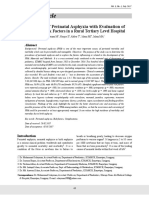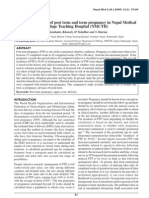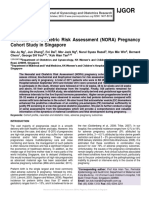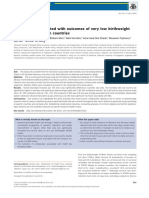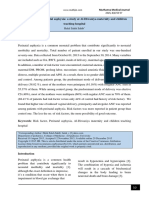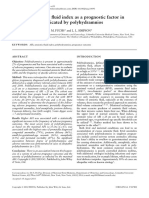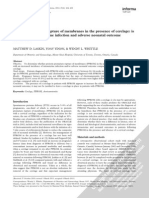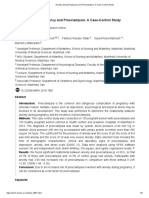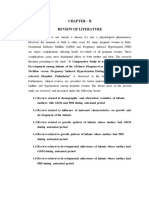0 ratings0% found this document useful (0 votes)
46 viewsRisk Factors Associated With Birth Asphyxia in Phramongkutklao Hospital
Risk Factors Associated With Birth Asphyxia in Phramongkutklao Hospital
Uploaded by
Iga AmandaThis study aimed to determine risk factors for birth asphyxia by analyzing 450 women who delivered at Phramongkutklao Hospital in Bangkok, Thailand between January and December 2009. The risk factors found to be significantly associated with birth asphyxia included moderate to thick meconium, breech presentation, low birth weight less than 2,500 grams, intrapartum sedation with morphine or pethidine, and preterm delivery. Correct and timely management of at-risk deliveries may help reduce the incidence of severe birth asphyxia.
Copyright:
© All Rights Reserved
Available Formats
Download as PDF, TXT or read online from Scribd
Risk Factors Associated With Birth Asphyxia in Phramongkutklao Hospital
Risk Factors Associated With Birth Asphyxia in Phramongkutklao Hospital
Uploaded by
Iga Amanda0 ratings0% found this document useful (0 votes)
46 views7 pagesThis study aimed to determine risk factors for birth asphyxia by analyzing 450 women who delivered at Phramongkutklao Hospital in Bangkok, Thailand between January and December 2009. The risk factors found to be significantly associated with birth asphyxia included moderate to thick meconium, breech presentation, low birth weight less than 2,500 grams, intrapartum sedation with morphine or pethidine, and preterm delivery. Correct and timely management of at-risk deliveries may help reduce the incidence of severe birth asphyxia.
Original Description:
journal medical asfiksia neo
Original Title
journalfile_360165
Copyright
© © All Rights Reserved
Available Formats
PDF, TXT or read online from Scribd
Share this document
Did you find this document useful?
Is this content inappropriate?
This study aimed to determine risk factors for birth asphyxia by analyzing 450 women who delivered at Phramongkutklao Hospital in Bangkok, Thailand between January and December 2009. The risk factors found to be significantly associated with birth asphyxia included moderate to thick meconium, breech presentation, low birth weight less than 2,500 grams, intrapartum sedation with morphine or pethidine, and preterm delivery. Correct and timely management of at-risk deliveries may help reduce the incidence of severe birth asphyxia.
Copyright:
© All Rights Reserved
Available Formats
Download as PDF, TXT or read online from Scribd
Download as pdf or txt
0 ratings0% found this document useful (0 votes)
46 views7 pagesRisk Factors Associated With Birth Asphyxia in Phramongkutklao Hospital
Risk Factors Associated With Birth Asphyxia in Phramongkutklao Hospital
Uploaded by
Iga AmandaThis study aimed to determine risk factors for birth asphyxia by analyzing 450 women who delivered at Phramongkutklao Hospital in Bangkok, Thailand between January and December 2009. The risk factors found to be significantly associated with birth asphyxia included moderate to thick meconium, breech presentation, low birth weight less than 2,500 grams, intrapartum sedation with morphine or pethidine, and preterm delivery. Correct and timely management of at-risk deliveries may help reduce the incidence of severe birth asphyxia.
Copyright:
© All Rights Reserved
Available Formats
Download as PDF, TXT or read online from Scribd
Download as pdf or txt
You are on page 1of 7
VOL. 19, NO. 4, OCTOBER 2011 165 Pitsawong C. et al.
Risk Factors Associated with Birth Asphyxia in
Phramongkutklao Hospital
Thai Journal of Obstetrics and Gynaecology
October 2011, Vol. 19, pp. 165-171
OBSTETRICS
Ri sk Factors Associ ated wi th Bi rth Asphyxi a i n
Phramongkutklao Hospital
Chayasak Pitsawong MD*,
Prisana Panichkul MD**.
* Department of Obstetrics and Gynecology, Phramongkutklao Hospital, Bangkok, Thailand
**Maternal-Fetal Medicine Unit, Obstetrics and Gynecology, Phramongkutklao Hospital, Bangkok, Thailand
ABSTRACT
Objective: To determine the risk factors for birth asphyxia
Materials and Methods: After obtaining the approval from the Institutional Review Board, a
retrospective case-control study recruited 450 women who delivered at Phramongkutklao
Hospital between January 1, and December 31, 2009 were recruited by consecutive selection.
The study sample comprised 150 women who delivered newborns with an APGAR score at 1
minute of 7 or less, while the control comprised 300 women who delivered newborns with an
APGAR score at 1 minute more than 7. The risk factors for birth asphyxia were determined.
Result: The risk factors associated with birth asphyxia included moderate to thick meconium
(OR 5.51, 95% CI 2.58-11.77), breech presentation (OR 4.53, 95% CI 1.72-11.92), birth weight
< 2,500 grams (OR 2.46, 95% CI 1.4-4.29), sedation with morphine or pethidine (OR 2.29, 95%
CI 1.37-3.84) and preterm delivery (OR 2.08, 95% CI 1.24-3.51).
Conclusion: Most risk factors associated with birth asphyxia can be prevented. Therefore the
correct, quick and accurate diagnosis and proper management can reduce severe birth asphyxia.
Keywords: birth asphyxia, risk factor
Introduction
Asphyxia is a condition that occurs when there
is an impairment of blood-gas exchange, resulting in
hypoxemi a (l ack of oxygen) and hypercapni a
(accumulation of carbon dioxide). The combination of
the decrease in oxygen supply (hypoxia) and blood
supply (ischemia) results in a cascade of biochemical
changes inside the body, whose events lead to neuronal
cell death and brain damage. Continuous asphyxia will
also lead to multiple organ systems dysfunction. Thus,
birth asphyxia is a serious clinical problem worldwide
and contributes greatly to neonatal mortality and
morbidity
(1)
The World Health Organization (WHO)
estimates that globally, between four and nine million
newborns suffer birth asphyxia each year. Birth
asphyxia leads to an estimated 1.2 million deaths and
about the same number of infants who develop severe
consequences, such as epilepsy, cerebral palsy, and
developmental delay. WHO estimates for global
neonatal deaths caused by birth asphyxia are 29%
(2)
.
VOL. 19, NO. 4, OCTOBER 2011 166 Thai J Obstet Gynaecol
Birth asphyxia can be caused by events that have their
roots in either the antepartum or intrapartum and involve
fetal factors or combinations thereof.
The WHOs classifcation of diseases according
to ICD 10 (The International Classifcation of Disease
10) defnes birth asphyxia where the APGAR score at
1 minute is less than or equal to 7 by the two levels.
Severe birth asphyxia is defned where the APGAR
score at 1 minute is 0-3 and slight or moderate (mild or
moderate birth asphyxia) is defned where the APGAR
score at 1 minute is 4-7
(3)
. Other risk factors associated
with birth asphyxia were moderate to thick meconium-
stained amniotic fuid, breech presentation, birthweight
<2,500 g, intrapartum sedation with morphine or
pethidine and preterm delivery.
According to the Tenth Thai National Health
Development Plan, birth asphyxia should be reduced
to less than 30 per 1,000 live births. However, the
incidence of birth asphyxia in Phramongkutklao
Hospital is higher. In 2008 and 2009, the incidence of
birth asphyxia was 100.76 and 90.20 per 1,000 live
births, respectively.
Therefore, we conducted this study to determine
the risk factors associated with birth asphyxia in
Phramongkutklao Hospital, to be used as basic
information for preventing birth asphyxia in the future.
Materials and Methods
After approved by the Institutional Review Board
of the Royal Thai Army Medical Department, a
retrospective case-control study was conducted. All
parturients with a gestational age of 28 weeks or more
or fetal birth weight of 1,000 g or more were recruited.
However, those who delivered fetuses with a major
congenital anomaly or women with intrauterine fetal
death or a stillbirth were excluded. The data were
collected from January 1, to December 31, 2009 at
Phramongkutklao Hospital. A total of 2,306 deliveries
occurred during the study period. All pregnant women
who delivered newborns with an APGAR score at 1
minute of 7 or less were included in the study group
and the control group comprised pregnant women who
delivered newborns with an APGAR score at 1 minute
> 7. The sample size calculation was determined by
two proportion mean formula
(4)
. Method for selecting
the population in each group was consecutive selection
with the ratio of 1 to 2 between study and control groups,
i.e., 150 cases 300 cases were required in the study
and control group, respectively.
The collected data were divided into three groups;
maternal, intrapartum and neonatal factors. Maternal
or antepartum factors included maternal age, gestational
age, hypertension, diabetes mellitus and antenatal clinic
(ANC) follow-up less than 4 visits. Intrapartum factors
comprised breech presentation, chorioamnionitis,
oligohydramnios, meconium in amniotic fuid, premature
rupture of membranes more than 18 hours, sedation
with morphine or pethidine and route of delivery. In
addition, fetal factors consisted of intrauterine growth
restriction (IUGR), twin pregnancy, birthweight less than
2,500 grams, preterm delivery and fetal distress.
The demographic data was determined by mean
and percentage. Student t-test was used to compare
the significant contributing factors as appropriate.
Association between birth asphyxia and risk factors
was determined by logistic regression. The potential
risk factors were determined by multiple logistic
regression. The signifcant level was defned as a
p-value < 0.05. The percentage of risk factors
associated with birth asphyxia at different intensity
levels was estimated with odds ratio and 95%
confdence interval (CI).
Result
The demographic data of the recruited women
are shown (Table 1). The average age in the study
group and control group was 28.29 and 28.39 years,
respectively. The gestational age of the study group
was 38.07 weeks and of the control group was 37.35
weeks. The primigravidarum in the study group
comprised 80 cases and 132 cases in the control group
whereas multigravidarum comprised 70 cases and
168 cases, respectively. Maternal or antepartum factors,
of the study group compared with those of the control
group are shown (Table 2).
Breech presentation moderate to thick meconium-
VOL. 19, NO. 4, OCTOBER 2011 167 Pitsawong C. et al. Risk Factors Associated with Birth Asphyxia in
Phramongkutklao Hospital
stained amniotic fuid, as well as intrapartum sedation
with morphine or pethidine were signifcantly associated
with birth asphyxia as shown (Table 3).
Regarding fetal factors, fetal birth weight less
than 2,500 grams (OR 2.40, 95% CI 1.42-4.04) and
preterm delivery (OR 2.08, 95% CI 1.24-3.51) were
signifcantly related to birth asphyxia as demonstrated
in Table 4. However, intrauterine growth restriction, twin
pregnancy and diagnosis of fetal distress were not
signifcantly related to birth asphyxia.
Signifcant risk factors for birth asphyxia were
further analyzed by multiple logistic regression model.
Factors that were independently associated with birth
asphyxia included moderate to thick meconium-stained
amniotic fuid (OR 5.51, 95% CI 2.58-11.77), breech
presentation (OR 4.53, 95% CI 1.72-11.92), birthweight
less than 2,500 grams (OR 2.46, 95% CI 1.40-4.29),
sedation with morphine or pethidine (OR 2.29, 95% CI
1.37-3.84) and preterm delivery (OR 2.08, 95% CI 1.24-
3.51) (Table 5).
Table 1. Demographic data (mean/percentage)
Demographic data Study group(n=150) Control group (n=300)
1. Maternal age (years) 28.29 28.33
2. Gestational age (weeks) 38.07 37.35
3. Primigravidarum 80 132
4. Multigravidarum 70 168
Table 2. Antepartum factors
Maternal factors
Study group
(n=150)
Control group
(n=300)
OR (95% CI) p-value*
n % n %
1. Maternal age 17 years 9 6.04 22 7.33 0.79 (0.35-1.77) 0.57
2. Maternal age 35 years 16 10.74 38 12.67 0.81 (0.43-1.51) 0.52
3. ANC < 4 visits 1 0.67 5 1.67 0.39 (0.04-3.44) 0.40
4. Primigravidarum 80 53.02 132 44.00 1.43 (0.96-2.13) 0.07
5. Multigravidarum 70 46.98 168 56.00 1.00 (0.96-2.13) 0.07
6. Hypertension 9 6.04 14 4.67 1.31 (0.55-3.10) 0.53
7. Diabetes mellitus 9 6.04 13 4.33 1.41 (0.59-3.39) 0.43
*Statistically signifcant if p <0.05
VOL. 19, NO. 4, OCTOBER 2011 168 Thai J Obstet Gynaecol
Table 3. Intrapartum factors
Intrapartum factor
Study group
(n=150)
Control group
(n=300)
OR (95% CI) p-value*
n % n %
1. Breech presentation 14 9.40 8 2.67 3.78
(1.55-9.23)
(0.28-14.53)
(0.33-6.88)
(0.13-1.18)
(2.12-9.08)
(0.05-4.51)
(1.14-2.97)
0.003
2. Chorioamnionitis 2 1.34 2 0.67 2.02 0.48
3. Oligohydramnios 3 2.01 4 1.33 1.52 0.58
4. Mild meconium 4 2.68 22 7.33 0.40 0.09
5. Moderate to thick meconium 24 16.11 12 4.00 4.39 0.001
6. PROM > 18 hours 1 0.67 4 1.33 0.50 0.53
7. Sedation 68 45.64 106 35.33 1.84 0.01
8. Vacuum or forceps extraction 10 6.71 10 3.33 2.18 (0.87-5.42) 0.09
9. Cesarean section 46 30.87 87 29.00 1.15 (0.74-1.78) 0.51
*Statistically signifcant if p <0.05
Table 4. Fetal factors
Fetal factors
Study group
(n=150)
Control group
(n=300)
OR (95% CI) p-value*
n % n %
1. IUGR 1 0.67 3 1.00 0.66 (0.06-6.48) 0.72
2. Twin pregnancy 7 4.70 8 2.67 1.79 (0.63-5.06) 0.26
3. Birthweight < 2,500 grams 35 23.49 34 11.33 2.40 (1.42-4.04) 0.001
4. Preterm delivery 33 22.15 36 12.00 2.08 (1.24-3.51) 0.006
5. Fetal distress 12 8.05 11 3.69 2.28 (0.98-5.31) 0.055
*Statistically signifcant if p <0.05
Table 5. Multiple logistic regression analysis
Risk factors OR (95% C.I) p-value*
1. Moderate to thick meconium
5.51 (2.58-11.77) <0.001
2. Breech presentation
4.53 (1.72-11.92) 0.002
3. Birthweight < 2,500 grams
2.46 (1.40-4.29) 0.002
4. Sedation with morphine or pethidine
2.29 (1.37-3.84) 0.002
5. Preterm delivery 2.08 (1.24-3.51) 0.006
*Statistically signifcant if p <0.05
VOL. 19, NO. 4, OCTOBER 2011 169 Pitsawong C. et al. Risk Factors Associated with Birth Asphyxia in
Phramongkutklao Hospital
Discussion
Risk factors of birth asphyxia in this study
included preterm delivery, which was 2.08 times that
of the control group. Similar results were reported in
prior studies
(5-10)
. Preterm babies have a variety of
morbidities, largely due to organ system immaturity,
especially lung immaturation causing respiratory
distress syndrome (RDS) in infants after birth. In the
case of preterm labor, it is important to make a diagnosis
and fnd the cause to provide appropriate management
to prevent preterm delivery.
On t he cont rar y, ot her factors such as
chorioamnionitis, oligohydramnios, route of delivery,
PROM longer than 18 hours, IUGR, fetal distress and
twins were found to be the risk factors of birth asphyxia
in previous studies
(5,7)
but did not affect the incidence
of birth asphyxia in the present study. Possible
explanations included the small sample size contributed
to the observed negative correlation of this factor and
also because of the different studied population.
Maternal age and parity were not associated
with birth asphyxia in this study, similar to those in
the study of Praditsathawong S, et al
(11)
. The present
study reaffirms that most birth asphyxia results are
strongly associated with pregnancy factors such as
moderate to thick meconium-stained amniotic fuid,
breech presentation, fetal birth weight < 2,500 grams,
intrapartum sedation with morphine or pethidine and
preterm delivery.
The strongest risk factor associated with asphyxia
in this study was moderate to thick meconium-stained
amniotic fuid. This factor was associated with asphyxia
was 5.51 times higher than clear amniotic fuid which
was the same as in previous studies
(1,5-7,12)
. Those with
mild or thin meconium-stained amniotic fuid were not
found to relate to birth asphyxia in this study. In healthy,
well-oxygenated fetuses, this diluted meconium is
readily cleared from the lungs by normal physiological
mechanisms. In some cases, however, the inhaled
meconium is not cleared, and meconium aspiration
syndrome results. It can occur after normal labor, but
is more likely when the meconium is thick
(13)
. If the
meconium-stained amniotic fluid was presented,
immediate endotracheal meconium suction after
delivery could reduce meconium aspiration syndrome.
Breech presentation exhibited a 4.53 times higher
risk of birth asphyxia than other presentations similar to
previous studies
(5,8,9,12)
. The assumption is that breech
presentation has a high rate of umbilical cord prolapse,
head entrapment, birth trauma and also increased
perinatal mortality. This result was supported by the
study of Hannah ME and colleagues
(14)
comparing the
planned caesarean section to the planned vaginal birth
for breech presentation at term revealing that perinatal
mortality, neonatal mortality, or serious neonatal
morbidity was significantly lower for the planned
caesarean section group than for the planned vaginal
birth group. Also, the meta-analysis study of infant
outcomes after breech delivery by Gifford DS et al
(15)
and Su M et al
(16)
suggests an increased risk of injury
and injury or death after a trial of labor.
Risk of asphyxia in fetal birth weight less than
2,500 grams was 2.46 times more at risk compared
with fetal birth weight more than 2,500 grams similar
to previous reports
(12,17-19)
. Low birthweight (LBW)
infants are often related to maternal complications such
as anemia, hypertension, and diabetes that present
preconception or antepartum. To decrease the risk
of LBW, in the case of previously described maternal
conditions, these pregnant women should be advised to
take care of themselves or try to cease or decrease their
risky activities that cause LBW fetuses (e.g., smoking,
alcohol consumption, etc.).
Intrapartum sedation with morphine or pethidine
also had signifcant association with birth asphyxia,
as demonstrated in previous studies
(5-7,9,10)
. These
opioids readily cross the placenta and for pethidine -
its half-life in the newborn is approximately 13 hours
or longer
(20)
. Narcotics used during labor may cause
newborn respiratory depression with the depressant
effect in the fetus that follows closely behind the peak
maternal analgesic effect. However, parental use of
these narcotics during labor is optional for pain relief.
The appropriate drug selection and appropriate time of
administration with early recognition of problems and
concerns after use is important.
VOL. 19, NO. 4, OCTOBER 2011 170 Thai J Obstet Gynaecol
Conclusion
Most risk factors associated with birth asphyxia
can be prevented. Therefore, the timely and accurate
diagnosis and proper management can reduce severe
birth asphyxia.
Acknowledgments
We woul d l i ke to t hank t he Di rector of
the Department of Obstetrics and Gynecology,
Phramongkutklao Hospital for the wholehearted
support of this study. We also appreciate all the helpful
recommendations and valuable information of all the
staff of our department. Finally, We are very grateful
for all of the patients and the nurse staffs for their
cooperation.
References
1. Adcock LM, Stark AR. Systemic effects of perinatal
asphyxia. Up-To-Date version 18.3. [Internet] 2010
[updated 2010 August 23; cited 2010 Dec 15]. Available
from: URL: http://www.uptodate.com.
2. Lawn JE, Cousens S, Zupan J. 4 million neonatal deaths:
When? Where? Why? Lancet 2005;365:891-900.
3. The International Classifcation of Disease 10 Revision
Thai Modifcation Volume 2. Ministry of public health
Bureau of policy and strategy office of the permanent
secretary, second ed 2006; 265.
4. Lertsakornsiri M. Risk factors associated with birth
asphyxia in Lampang Hospital. Lampang Med 2003; 28:
1-11.
5. Wongsang N. Risk factors associated with birth asphyxia
in Samutprakarn Hospital. Bull Dept Med Serv 2000; 25:
78-86.
6. Taweethammasathit T. Risk factors associated with
APGAR score 7 at birth in Mukdahan Hospital. Medical
J of Ubon Hospital 2004; 25: 273-82.
7. Lee AC, Mullany LC, Tielsch JM, Katz J, Khatry SK,
LeClerq SC, et al. Risk factors for neonatal mortality
due to birth asphyxia in southern Nepal: a prospective,
community-based cohort study. Pediatrics 2008;121:
1381-90.
8. Chandra S, Ramji S, Thirupuram S. Perinatal asphyxia:
multivariate analysis of risk factors in hospital births.
Indian Pediatr 1997; 34: 206-12.
9. Kerdarunsree A. Prevalence and factors associated with
birth asphyxia in Ratchapiphat Hospital. Vajira Med J
2004; 48: 79-86.
10. Milsom I, Ladfors L, Thiringer K, Niklasson A, Odeback
A, back A, Thornberg E. Infuence of maternal, obstetric
and fetal risk factors on the prevalence of birth asphyxia
at term in a Swedish urban population. Acta Obstet
Gynecol Scand 2002;81:90917.
11. Praditsathawong S, Nimitsurachat S. Risk factor
associated with low APGAR score of new born at 1
minute. Thai J Obstet Gynaecol 2000; 12: 277-82.
12. Chen ZL, He RZ, Peng Q, Guo KY, Zhang YQ, Yuan HH,
et al. Prenatal risk factors for neonatal asphyxia: how risk
for each? Zhongguo Dang Dai Er Ke Za Zhi 2009; 11:
161-5.
13. Cunningham FG, Leveno KJ, Bloom SL, Hauth JC,
Rouse DJ, Spong CY, editors. Williams Obstetrics.
23rded. New York: McGraw-Hill; 2005. p. 605-45.
14. Hannah ME, Hannah WJ, Hewson SA, Hodnett ED,
Saigal S, Willan AR. Planned caesarean section versus
planned vaginal birth for breech presentation at term:
a randomised multicentre trial. Term Breech Trial
Collaborative Group. Lancet 2000 ; 21; 356(9239):1375-
83.
15. Gifford DS, Morton SC, Fiske M, Kahn K. A meta-analysis
of infant outcomes after breech delivery. Obstet Gynecol
1995; 85:1047-54.
16. Su M, McLeod L, Ross S, Willan A, Hannah WJ, Hutton E,
et al. Factors associated with adverse perinatal outcome
in the Term Breech Trial. Am J Obstet Gynecol 2003 ;189:
740-5.
17. Panichwattana C, Thammadee S, Khemkhang T. Factors
infuenced birth asphyxia at Uttaradit Hospital. Region 8
Med J 2000; 8: 53-66.
18. Pajjokkhuppati L. Obstetric risk factors influenced
APGAR score 7 at 1 minutes after birth and the effect to
fetus in Suratthanee Hospital. Region 11 Med J 2002;16:
21-33.
19. Jittawarhodome T. Birth asphyxia in Satul Hospital.
Region 12 Med J 2545;13: 43-54.
20. American College of Obstetricians and Gynecologists:
Obstetric analgesia and anesthesia. Int J Gynaecol
Obstet 2002;78:321-35.
VOL. 19, NO. 4, OCTOBER 2011 171 Pitsawong C. et al. Risk Factors Associated with Birth Asphyxia in
Phramongkutklao Hospital
,
:
:
450
consecutive selection 1 2552 31 2552 450
2 (APGAR < 7) 150 (APGAR > 7) 300
: (OR 5.51,
95% CI 2.58-11.77), (OR 4.53, 95% CI 1.72-11.92), < 2,500 (OR 2.46, 95%
CI 1.4-4.29), morphine pethidine (OR 2.29, 95% CI 1.37-3.84) 37
(OR 2.08, 95% CI1.24-3.51)
:
You might also like
- Nursing Care Plan Diabetes Mellitus Type 2Document2 pagesNursing Care Plan Diabetes Mellitus Type 2deric88% (76)
- Government College of Nursing, Raipur (C.G.) : Neurological ExaminationDocument17 pagesGovernment College of Nursing, Raipur (C.G.) : Neurological ExaminationBabita Dhruw100% (2)
- Vol93 No.6 661 5058Document6 pagesVol93 No.6 661 5058Titi Afrida SariNo ratings yet
- Risk Factors of Neonatal Sepsis: A Preliminary Study in Dr. Soetomo HospitalDocument4 pagesRisk Factors of Neonatal Sepsis: A Preliminary Study in Dr. Soetomo HospitalMeycha Da FhonsaNo ratings yet
- 33873-Article Text-121761-1-10-20170831Document6 pages33873-Article Text-121761-1-10-20170831AnggaNo ratings yet
- V615br MarhattaDocument4 pagesV615br MarhattaMarogi Al AnsorianiNo ratings yet
- Maternal Hypothyroidism During Pregnancy and The Risk of Pediatric Endocrine Morbidity in The OffspringDocument6 pagesMaternal Hypothyroidism During Pregnancy and The Risk of Pediatric Endocrine Morbidity in The OffspringlananhslssNo ratings yet
- Obgyn 1Document4 pagesObgyn 1Auzia Tania UtamiNo ratings yet
- AsdasfasfvDocument7 pagesAsdasfasfvPulseWangminNo ratings yet
- Predictive Factors For Preeclampsia in Pregnant Women: A Unvariate and Multivariate Logistic Regression AnalysisDocument5 pagesPredictive Factors For Preeclampsia in Pregnant Women: A Unvariate and Multivariate Logistic Regression AnalysisTiti Afrida SariNo ratings yet
- Neonatal and Obstetric Risk Assessment (NORA) Pregnancy Cohort Study in SingaporeDocument7 pagesNeonatal and Obstetric Risk Assessment (NORA) Pregnancy Cohort Study in SingaporePremier PublishersNo ratings yet
- Chorioamnionitis and Prognosis For Term Infants-13Document5 pagesChorioamnionitis and Prognosis For Term Infants-13ronny29No ratings yet
- R. Irvian1Document5 pagesR. Irvian1Ermawati RohanaNo ratings yet
- The NeoUpdates - DecDocument7 pagesThe NeoUpdates - DecDr Satish MishraNo ratings yet
- Incidence and Risk Factors of Pre-Eclampsia in The Paropakar Maternity and Women's Hospital, Nepal: A Retrospective StudyDocument8 pagesIncidence and Risk Factors of Pre-Eclampsia in The Paropakar Maternity and Women's Hospital, Nepal: A Retrospective StudyJod BellNo ratings yet
- 10 1111@jog 13886Document5 pages10 1111@jog 13886Septian WidiantoNo ratings yet
- P ('t':'3', 'I':'3053807383') D '' Var B Location Settimeout (Function ( If (Typeof Window - Iframe 'Undefined') ( B.href B.href ) ), 15000)Document4 pagesP ('t':'3', 'I':'3053807383') D '' Var B Location Settimeout (Function ( If (Typeof Window - Iframe 'Undefined') ( B.href B.href ) ), 15000)Ni Wayan Ana PsNo ratings yet
- The Effects of Threatened Abortions On Pregnancy OutcomesDocument6 pagesThe Effects of Threatened Abortions On Pregnancy OutcomesfrankyNo ratings yet
- Nidhi Thesis PresentationDocument25 pagesNidhi Thesis Presentationujjwal souravNo ratings yet
- Jurnal Gangguan PernafasanDocument12 pagesJurnal Gangguan PernafasanNilna Ulumiyah100% (1)
- 758ea1d4-f2d2-4b49-8ea1-d6a97ebdea6fDocument22 pages758ea1d4-f2d2-4b49-8ea1-d6a97ebdea6fAmsalu ShitaNo ratings yet
- Review Article: Maternal Preeclampsia and Neonatal OutcomesDocument8 pagesReview Article: Maternal Preeclampsia and Neonatal OutcomesMita RestuNo ratings yet
- Prothrombin Time and Activated Partial Thromboplastin Time in Pregnant Women Attending Antenatal Clinic at Nnamdi Azikiwe University Teaching Hospital (Nauth), Nnewi, Nigeria - A Cohort StudyDocument4 pagesProthrombin Time and Activated Partial Thromboplastin Time in Pregnant Women Attending Antenatal Clinic at Nnamdi Azikiwe University Teaching Hospital (Nauth), Nnewi, Nigeria - A Cohort StudyasclepiuspdfsNo ratings yet
- Dyq 030Document10 pagesDyq 030Marlintan Sukma AmbarwatiNo ratings yet
- Tocolysis - A Clinically Based ReviewDocument29 pagesTocolysis - A Clinically Based ReviewAulya Adha DiniNo ratings yet
- Journal (Preterm Labor)Document5 pagesJournal (Preterm Labor)Zhyraine Iraj D. CaluzaNo ratings yet
- Protocol Poojitha CompletedDocument15 pagesProtocol Poojitha CompletedPranav SNo ratings yet
- PT Resp OutcomesDocument6 pagesPT Resp OutcomesHarish SudarsananNo ratings yet
- Comparative Study of Nifedipine and Isoxpurine As Tocolytics For Preterm LaborDocument4 pagesComparative Study of Nifedipine and Isoxpurine As Tocolytics For Preterm LaborMeitika Wahyu Wedha WatiNo ratings yet
- Hypertension in PregnancyDocument11 pagesHypertension in Pregnancyadughjacob3No ratings yet
- Shimokaze Et Al-2015-Journal of Obstetrics and Gynaecology ResearchDocument8 pagesShimokaze Et Al-2015-Journal of Obstetrics and Gynaecology ResearchMusa LandeNo ratings yet
- Herrera 2017Document9 pagesHerrera 2017Bianca Maria PricopNo ratings yet
- Mihu 2015Document7 pagesMihu 2015Nuryasni NuryasniNo ratings yet
- Lafalla 2019Document26 pagesLafalla 2019Chicinaș AlexandraNo ratings yet
- EUROMEDLAB 2013 PostersDocument101 pagesEUROMEDLAB 2013 PostersidownloadbooksforstuNo ratings yet
- Elective Delivery Versus Expectant Management For Pre-Eclampsia: A Meta-Analysis of RctsDocument16 pagesElective Delivery Versus Expectant Management For Pre-Eclampsia: A Meta-Analysis of RctsErliana Damayanti100% (1)
- Omj D 09 00101Document6 pagesOmj D 09 00101DewinsNo ratings yet
- W 3 RT 2 QwfcavfgsbszDocument6 pagesW 3 RT 2 QwfcavfgsbszkennydimitraNo ratings yet
- Expectant Versus Aggressive Management in Severe Preeclampsia Remote From TermDocument6 pagesExpectant Versus Aggressive Management in Severe Preeclampsia Remote From Termmiss.JEJENo ratings yet
- Ischemia-Modified Albumin Levels in Threatened Abortion and Missed Abortion Compared To Healthy Pregnancies (#1399320) - 3574292Document6 pagesIschemia-Modified Albumin Levels in Threatened Abortion and Missed Abortion Compared To Healthy Pregnancies (#1399320) - 3574292Anna PeaceNo ratings yet
- Risk Factors of Perinatal Asphyxia A Study at Al Diwaniya Maternity and Children Teaching HospitalDocument8 pagesRisk Factors of Perinatal Asphyxia A Study at Al Diwaniya Maternity and Children Teaching HospitalRizky MuharramNo ratings yet
- Vol9 Issue1 06Document4 pagesVol9 Issue1 06annisaNo ratings yet
- Maximal Amniotic Fluid Index As A Prognostic Factor in Pregnancies Complicated by PolyhydramniosDocument6 pagesMaximal Amniotic Fluid Index As A Prognostic Factor in Pregnancies Complicated by PolyhydramniosNidiaPurwadiantiNo ratings yet
- Preterm Premature Rupture of Membranes in The Presence of Cerclage: Is The Risk For Intra-Uterine Infection and Adverse Neonatal Outcome Increased?Document6 pagesPreterm Premature Rupture of Membranes in The Presence of Cerclage: Is The Risk For Intra-Uterine Infection and Adverse Neonatal Outcome Increased?stephaniedianNo ratings yet
- Obstetrics 5Document10 pagesObstetrics 5DownloadNo ratings yet
- Ijmpo 3 (3) 102-105Document4 pagesIjmpo 3 (3) 102-105Sunil KothariNo ratings yet
- Medicina 59 01151Document9 pagesMedicina 59 01151Lissaberti AmaliahNo ratings yet
- Tugas Kelompok NewDocument15 pagesTugas Kelompok NewTini Ahmad ArkanNo ratings yet
- Anxiety During Pregnancy and Preeclampsia - A Case-Control StudyDocument9 pagesAnxiety During Pregnancy and Preeclampsia - A Case-Control StudyJOHN CAMILO GARCIA URIBENo ratings yet
- Prolonged Second Stage of Labour, Maternal Infectious Disease, Urinary Retention and Other Complications in The Early Postpartum PeriodDocument9 pagesProlonged Second Stage of Labour, Maternal Infectious Disease, Urinary Retention and Other Complications in The Early Postpartum PeriodCordova ArridhoNo ratings yet
- Maternal and Fetal Outcomes in Term Premature Rupture of MembraneDocument6 pagesMaternal and Fetal Outcomes in Term Premature Rupture of MembraneMuhammad Fikri RidhaNo ratings yet
- 5BJPCBS201005.195D20Holanda20et - Al .2C202019 PDFDocument15 pages5BJPCBS201005.195D20Holanda20et - Al .2C202019 PDFputri vinia /ilove cuteNo ratings yet
- Prevalence and Risk Factors of Apnea in Preterm Neonates Admitted To The French Medical Institute For Mothers and Children HospitaDocument5 pagesPrevalence and Risk Factors of Apnea in Preterm Neonates Admitted To The French Medical Institute For Mothers and Children HospitaScivision PublishersNo ratings yet
- Preterm LaborDocument19 pagesPreterm LaborPrily RillyNo ratings yet
- Clinical Risk Factor For Preeclamsia in Twin PregnanciesDocument8 pagesClinical Risk Factor For Preeclamsia in Twin PregnanciesLouis HadiyantoNo ratings yet
- The Effects of Betamethasone On Clinical Outcome of The Late Preterm Neonates Born Between 34 and 36 Weeks of GestationDocument17 pagesThe Effects of Betamethasone On Clinical Outcome of The Late Preterm Neonates Born Between 34 and 36 Weeks of GestationjeffyNo ratings yet
- Chapter 3Document32 pagesChapter 3Vaibhav JainNo ratings yet
- Am J Perinatol. 2007 Jun24 (6) 373-6Document4 pagesAm J Perinatol. 2007 Jun24 (6) 373-6Ivan Osorio RuizNo ratings yet
- Pregnancy-Induced Hypertension Is An Independent Risk Factor For Meconium Aspiration Syndrome A Retrospective Population Based Cohort StudyDocument5 pagesPregnancy-Induced Hypertension Is An Independent Risk Factor For Meconium Aspiration Syndrome A Retrospective Population Based Cohort StudyRIECHELLE SEVILLANo ratings yet
- Complementary and Alternative Medical Lab Testing Part 10: ObstetricsFrom EverandComplementary and Alternative Medical Lab Testing Part 10: ObstetricsNo ratings yet
- Pregnancy Tests Explained (2Nd Edition): Current Trends of Antenatal TestsFrom EverandPregnancy Tests Explained (2Nd Edition): Current Trends of Antenatal TestsNo ratings yet
- Treatment Strategy for Unexplained Infertility and Recurrent MiscarriageFrom EverandTreatment Strategy for Unexplained Infertility and Recurrent MiscarriageKeiji KurodaNo ratings yet
- Greetings and Introductory QuestionDocument12 pagesGreetings and Introductory QuestionIga AmandaNo ratings yet
- Expertise CT Scan Kepala: BY Dr. Sandy IstantoDocument9 pagesExpertise CT Scan Kepala: BY Dr. Sandy IstantoIga AmandaNo ratings yet
- Fetal Response To Acute Hypoxic Ischemia and HIEDocument29 pagesFetal Response To Acute Hypoxic Ischemia and HIEDevi ParamitaNo ratings yet
- Term Prelabour Rupture of Membranes (Term Prom) (C-Obs 36) Review Mar 14Document12 pagesTerm Prelabour Rupture of Membranes (Term Prom) (C-Obs 36) Review Mar 14Iga AmandaNo ratings yet
- CS US Meneker and DeclerqueDocument15 pagesCS US Meneker and DeclerqueIga AmandaNo ratings yet
- UAS Inggris (Final Test)Document2 pagesUAS Inggris (Final Test)Iga AmandaNo ratings yet
- Ucc ExamsDocument8 pagesUcc Examsamponsah gloriaNo ratings yet
- Recommended Reading List For EDAIC 2019Document5 pagesRecommended Reading List For EDAIC 2019Bebo EsmatNo ratings yet
- Ten Teacher Single Best .AnswerDocument4 pagesTen Teacher Single Best .Answera7332773No ratings yet
- Lab 2: Anatomy of The Heart: General ConsiderationsDocument19 pagesLab 2: Anatomy of The Heart: General ConsiderationsDisshiNo ratings yet
- User GuideDocument10 pagesUser GuideBOYA MOHANNo ratings yet
- DiphenhydramineDocument3 pagesDiphenhydramineGwyn RosalesNo ratings yet
- Checklist: Aspiration/Aspiration PneumoniaDocument3 pagesChecklist: Aspiration/Aspiration PneumoniaWienaIbunyaKevinNo ratings yet
- IMM5955EDocument1 pageIMM5955Eraja.traveldeskNo ratings yet
- MIO SheetDocument1 pageMIO SheetjnetNo ratings yet
- Psychological Disorders Lecture NotesDocument30 pagesPsychological Disorders Lecture NotesmclucieNo ratings yet
- Base Line Chart of Target Behavior (Irritability) : AssignmentDocument2 pagesBase Line Chart of Target Behavior (Irritability) : AssignmentIsma ZameerNo ratings yet
- Operating RoomDocument23 pagesOperating RoomTheresa Bread86% (7)
- Sinarest TabDocument3 pagesSinarest Tabshobhana mulayNo ratings yet
- Dr. Syed Shakeel Ahmad: ObjectiveDocument3 pagesDr. Syed Shakeel Ahmad: ObjectiveSyed Shakeel AhmadNo ratings yet
- The Chain of InfectionDocument4 pagesThe Chain of Infectionapi-254489759No ratings yet
- Website-INICET Jan 24 2nd RoundDocument123 pagesWebsite-INICET Jan 24 2nd RoundChakshu AgrawalNo ratings yet
- Med1 Mukkamala ShreyaDocument6 pagesMed1 Mukkamala ShreyaCharlotte YeoNo ratings yet
- Chapter 1 Condensed Afmc Primer - September 2016Document11 pagesChapter 1 Condensed Afmc Primer - September 2016tgalksjflkjNo ratings yet
- Annotated BibDocument19 pagesAnnotated Bibapi-252208553No ratings yet
- Pharmacology: By: Nerissa Cabañero Laiza PinedaDocument121 pagesPharmacology: By: Nerissa Cabañero Laiza PinedaJacq CalaycayNo ratings yet
- The Finish Line: Sri Ramachandra Faculty of Dental SciencesDocument4 pagesThe Finish Line: Sri Ramachandra Faculty of Dental SciencesPradeep PradyNo ratings yet
- Precios F24 - BCV - 4.37$Document31 pagesPrecios F24 - BCV - 4.37$Genesis AlañaNo ratings yet
- Anatomy and PhysiologyDocument7 pagesAnatomy and PhysiologyKristine Alejandro100% (1)
- Admin, 043 - 835 - Putu Ayu Dewita Ganeswari - GalleyDocument8 pagesAdmin, 043 - 835 - Putu Ayu Dewita Ganeswari - GalleySafaNo ratings yet
- Peptic UlcerDocument53 pagesPeptic UlcerBassant Ahmed Mahmoud Ragab Abdallah AyaadNo ratings yet
- Ulthera IndicationsDocument3 pagesUlthera IndicationsThe Vancouver Sun100% (1)
- CholeraDocument11 pagesCholeraJanisNo ratings yet
- Group 1 - Chicken Dissection PDFDocument37 pagesGroup 1 - Chicken Dissection PDFMohammad Omar BacaramanNo ratings yet




